You can water a garden very well without a hosepipe. Practice now and you’ll be well prepared for a hosepipe ban.
I wince at seeing the way many gardeners overuse their hosepipes. Sprinklers spray a wasteful curve and even spray guns encourage overuse of our precious water resources. You can water a garden very well with a can and it needn’t take much longer than with a hosepipe. This blog will explain why.
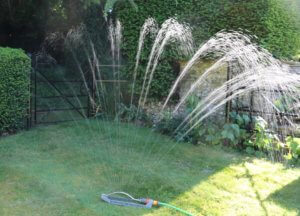
I have had to develop good techniques to water my garden and conserve water over a number of years. I am pleased to do so for environmental reasons but it is also necessary because I have a large garden. At 2 acres there is no way I can water everywhere. I am sure I use less water now than when I had a small courtyard garden. Back then I sprayed water around with insouciance, now I’m much more careful.
Here I describe how to water a garden wisely – to save you time, to save water and to ensure your plants thrive.
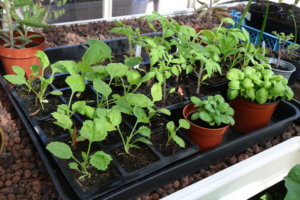
5 good reasons why it’s OK to ditch the hosepipe
Whilst most people see the use of a hosepipe to water a garden as labour saving, I genuinely think in most circumstances it isn’t. Here’s why.
- Weeds need water too. If you direct a flow from a watering can at the roots of a wanted plant it will thrive whilst the weeds around it wither and die. Spread a sprinkler in a wide curve over a large area and up will pop the weeds. A few minutes extra watering with a can will save many more of hot dusty weeding. It’s a rational decision.
- Plants do better with a deeper root run. Deep roots are encouraged through parsimonious watering. Give each plant a good drink when you first plant it, then only give it the minimum water it requires to stay alive. This will encourage its roots to travel down in search of moisture. Pamper a plant with regular shallow waterings in the early days and you will encourage the roots to stay at the surface – a problem in the long term.
- Not all plants need regular watering. Wandering around the garden with a hose it is tempting to throw some water on everything whether it needs it or not. It is far better to observe your plants and act when they are showing signs of wilt so you do not waste water on plants that just don’t need it. You will learn over time which plants need water more frequently and which will see out a drought quite happily with barely a drop. You can then target your watering effectively, knowing which need watering daily, which weekly and which never.
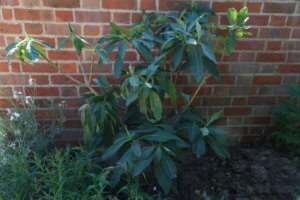
This Edgeworthia shrub needs some water. Its leaves are drooping and are not recovering in the cool of the evening.
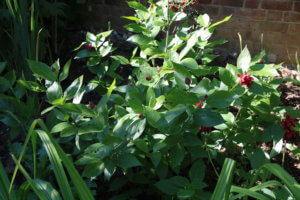
This Calycanthus shrub is planted just a metre from the Edgeworthia but does not need water.
- Hoses stop you investing in water saving devices and techniques. If you’ve got a hosepipe you are less likely to invest in water saving devices, to store water in butts and tanks or to make good decisions on plant choices. A few small cost effective strategies when planting will save you time watering in the long term. See below for some water-saving ideas.
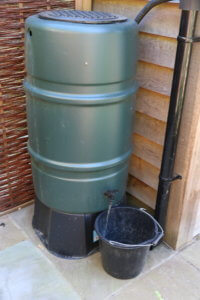
- Finally, come the hosepipe ban you’ll not know how to cope. You will be cursing the weather or the water company rather than enjoying a garden that can thrive regardless.
How to water the garden with watering cans
- Have two cans – one to be filling up whilst you water with the other. It can become a game to make sure you’ve finished watering before the second one fills but it certainly speeds things up and you can adjust your tap to fill slowly if necessary.
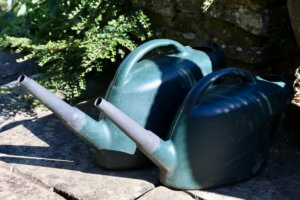
- Only use a rose to spread the water over a wider area if you’re watering trays of seedlings or small plants.
- Use the spout for bigger plants to direct a strong flow of water directly at the roots.
- Feed your plants whilst watering by using a dilute liquid tomato feed or liquid seaweed – you’ve done two jobs in one – and saved yourself time. Whilst you can get feed attachments for hoses, these are expensive and can be fiddly.
- Take the time to check your plants – using a can you need to get just that bit closer to your plants and so you’re more likely to see problems such as pests or happy things such as bud development.
Some good techniques to save water in the garden.
- When you plant a shrub or tree place a plastic pipe deep into the soil beside it. When it needs watering you use a watering can to pour water into the pipe, directly at the roots. Watering at the surface, a proportion will always evaporate away and be wasted.
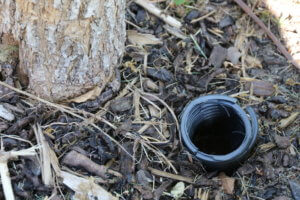
- In hot weather place a tray under seedlings or a dish under container plants. This seems simple but I’ve observed what a big difference this can make in hot weather. The tray will catch water running through your seed trays and provide a little reservoir for the plant to use between watering. Some plants do hate sitting in water but there aren’t many and in hot weather the water in the reservoir will be used quickly.
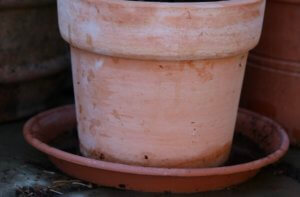
- Do not water during the heat of the day as you will waste allot of water to evaporation. Also many plants have techniques to save water by reducing their transpiration rate. Many droop their leaves in the heat of the day only to pop back up in the evening without additional water. Don’t panic yourself into watering.
- Avoid porous pots for container gardens. Terracotta is very attractive but in hot weather, moisture is lost through the clay of the pot. Good quality plastic containers can last a lifetime and some of the more expensive brands look like terracotta from a distance. Cheap plastic should be avoided as it will become brittle over time. Glazed pots are very pretty and can be expensive but will reduce water lost through the sides of the pot. If you want to persevere with terracotta, choose plants that or more drought resistant, stand them in a dish, line the terracotta with plastic sheet cut from old compost bags, or stand a plastic pot within the terracotta.
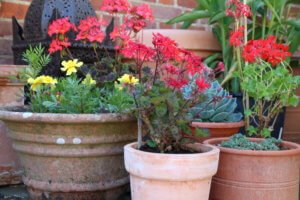
- Use a plastic bottle as a reservoir next to thirstier plants. Some people cut the bottle in half so it can be filled easily. Others keep the bottle intact, burn holes in the lid with a hot needle then plunge the bottle upside down into the soil. The water will slowly dissipate into the soil, encouraged when heat expands the trapped air at the top.
- I don’t bother with water retaining crystals. These are granules which can be mixed into your compost where they swell on watering to store extra water. I find this an unnecessary and more costly step in my planting process. I haven’t observed much difference in how long I can go between waterings.
- Collect water in water butts throughout the winter and use so-called grey water from your washing up or baths. Even a couple of watering cans from a bath used to water pots will make a huge difference to your water use over a long hot summer. Do not use water from a butt on small seedlings as this can contain fungal diseases that will affect your seedlings and causing damping off.
- Mulch you borders in early spring to retain moisture in the soil. I use compost from my compost bins for this although I often have to buy in bulk bag orders from local suppliers as I can rarely produce enough for all my borders. In a really long dry summer you will need to start watering some plants but I’ve noticed how moist the soil is under the mulch compared to unmulched beds. Plus – the mulch provides some nutrients and definitely improves soil structure over time.
Which plants are most drought tolerant?
Lawns – do not water your lawn. Grass is like the canary in the coal mine – it is shallow rooted and a sure sign that the soil is dry. However, unlike many other plants, grass can go completely brown, dry and crispy and bounce back green and glossy as soon as rain returns. Watering your lawn is a huge waste of water which is better deployed on plants that cannot survive without it. Avoid planting turf or sowing grass seed as summer approaches. Better to wait to Autumn when rain is more likely.
Roses – once established they should not need watering in a drought and will not die (although they may flower less). Even newly planted roses need little water
Herbs – rosemary, thyme, lavender can take the full force of a hot summer and little water but thrive regardless
Anything silver-leaved or hairy – Plants with silver or hairy leaves can reflect and conserve moisture.
Pelargoniums – These love drying out between waterings.
Alpines and succulents – Succulents can store water in their gel-like centres and alpines generally hail from mountainous regions with hot dry weather in summer.
Which plants need the most water?
Juicy fruits and vegetables – anything that glistens with moisture when you cut into it will need water to do well. Think tomatoes, strawberries, cucumbers, carrots, sweetcorn, peas and potatoes…
Conifers – these don’t necessarily need allot of water but will not recover if they dry out. I have accidentally lost a few conifers in pots where a couple of missed waterings meant they dropped all their needles. When this happens you’re beyond the point of no return.
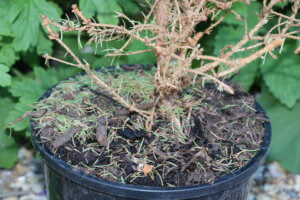
This conifer missed a few waterings, has lost its needles and will not recover.
Plants in small pots or containers or which have outgrown their pot – If a plant is too cramped it will quickly use all the water available to it. Hanging baskets and containers of annuals are often crammed as this creates a better display. It’s fine but you’ll need to water regularly.
Plants that get mildew – this is a disease which covers the leaves in a white powdery sheen but is preventable if you can keep on top of the watering and avoid spraying the leaves whilst watering. Sweet peas and squash are two examples of plants that get affected. you will still get flowers and fruit but the yield may be affected.
More information on watering can be found on the website of the Royal Horticultural Society.
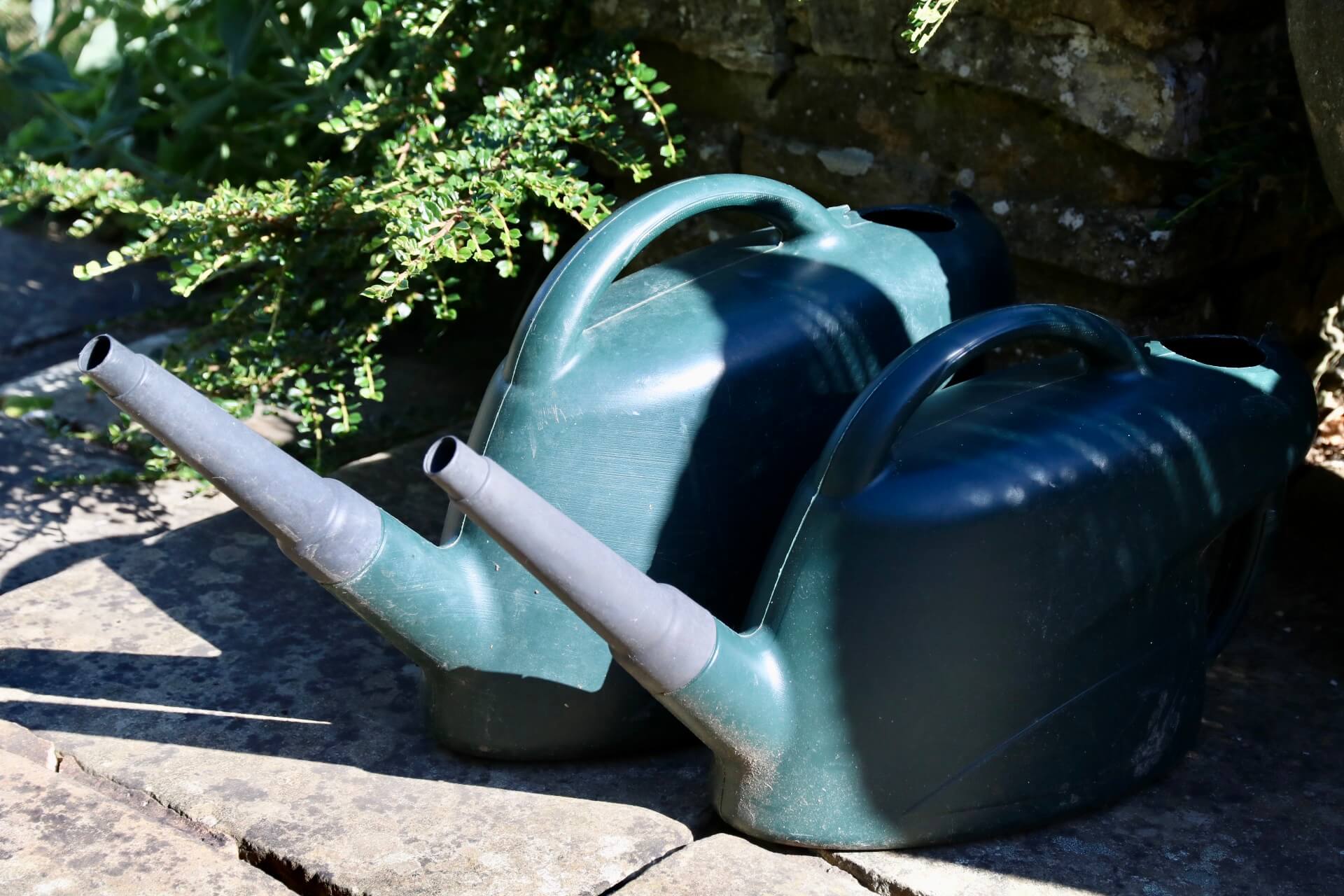
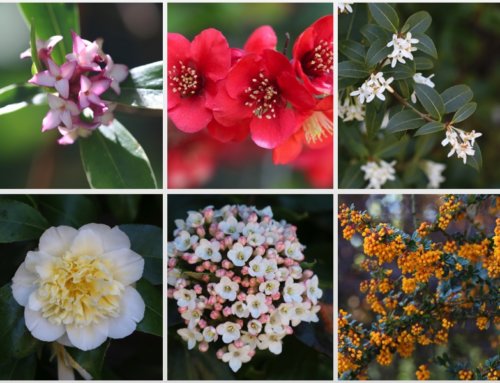
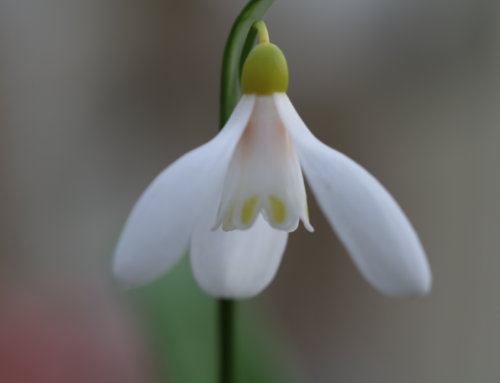
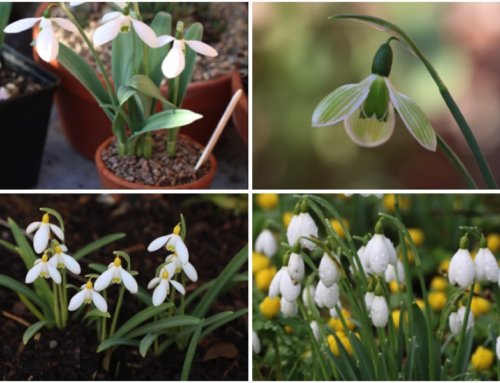
Katharine, I absolutely love your article and thoughts on watering with two cans, using water butts, and not using a hose pipe. I am totally like minded, and strangely enough find target watering with multiple cans in my 1/4 acre garden much faster than lugging a cumbersome hose pipe around! (I haven’t got the patience to untangle, guide the hosepipe around flowerbeds and then wind it up at the end). I’ve whizzed round with cans in half the time and been able to relax and smell the roses while I’m at it! Also using water from my 7 water butts in a can relay has the massive feel good factor of being eco minded and water sustainable too! Additionally, the water butts store the water where I need to use it, so it’s a convenient time saving system! I would love to think there are more ‘water wise’ environmentally friendly gardeners like us! How can we get this message to more people and encourage gardeners to try this eco efficient method?! 😃
Hi Jo – we’re like peas in a pod! I get very frustrated with tangled hoses too. I wrote this article hoping that it would help people when we have hosepipe bans, but of course these techniques are easy to follow at all times and can really reduce the amount of water we use from the mains. I think people on meters are generally more careful than those who aren’t as they can see the cost of watering in their bills. I don’t know how the message can be more widely shared but we definitely need to get to a point where it’s regarded as anti-social to have a bright green lawn during a drought!
Thank you for this article. It has cheered me up. I don’t have an outdoor tap, and I know from way-past experience that trying to fit a hosepipe onto an indoor tap is a disaster. I also had a particularly kinky hosepipe – so I threw it out. So, it’s watering cans for me, by necessity. I won’t waste any more emotion and time, bemoaning to myself that I don’t have tap/hosepipe. Because it’s in and out at the kitchen sink, I have 3 cans (and will probably add another 1 or 2). Fillem up and line-em up at back door for best flowing efficiency.
Bravo Prue – You’ll cope just fine, I’m sure.
Getting a sprinkler system installed seems like the best bet to me. It’s easy and hands free once it’s set up. That’s my opinion at least.
Yes, sprinklers are a good easy option and work very well in hot weather and when the sprinkler is directed at plants that need it, rather than to water wider areas that don’t need it. My worry is the waste of water if the sprinkler isn’t well directed, or if the timer isn’t adjusted for cooler damper weather. I’m on a water meter and every drop counts.